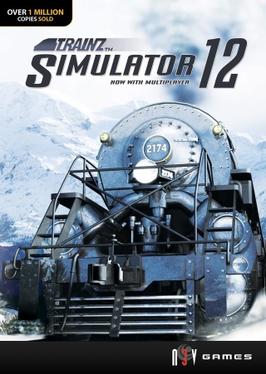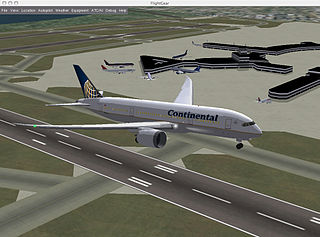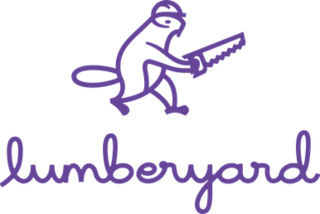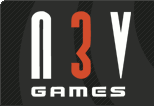
Microsoft Flight Simulator is a series of flight simulator programs for MS-DOS, Classic Mac OS, and Microsoft Windows operating systems. It was an early product in the Microsoft application portfolio and differed significantly from Microsoft's other software, which was largely business-oriented. Microsoft Flight Simulator is Microsoft's longest-running software product line, predating Windows by three years, and is one of the longest-running video game series of all time.
A game engine is a software framework primarily designed for the development of video games and generally includes relevant libraries and support programs such as a level editor. The "engine" terminology is akin to the term "software engine" used more widely in the software industry.

Gmax is an application based on Autodesk's 3ds Max application used by professional computer graphics artists. 3ds Max is a comprehensive modeling, animation and rendering package with some secondary post-production and compositing features. Gmax is much more limited due to its singular intended use—game content creation. Infrequently used tools and features, or the ones completely unrelated to creating 3D game models, were removed, leaving the core modeling, texturing, and basic animation rigging and keyframing capabilities. In 2005, the promotional freeware software was discontinued after version 1.2.

Trainz is a series of 3D train simulator video games. The Australian studio Auran released the first game in 2001.

A train simulator is a computer-based simulation of rail transport operations. They are generally large complicated software packages modeling a 3D virtual reality world implemented both as commercial trainers, and consumer computer game software with 'play modes' which lets the user interact by stepping inside the virtual world. Because of the near view modeling, often at speed, train simulator software is generally far more complicated software to write and implement than flight simulator programs.
Dynamix, Inc. was an American developer of video games from 1984 to 2001, best known for the flight simulator Red Baron, the puzzle game The Incredible Machine, the Front Page Sports series, Betrayal at Krondor, and the online multiplayer game Tribes.
Microsoft Flight Simulator began as a set of articles on computer graphics, written by Bruce Artwick throughout 1976, about flight simulation using 3-D graphics. When the editor of the magazine told Artwick that subscribers were interested in purchasing such a program, Artwick founded Sublogic Corporation to commercialize his ideas. At first the new company sold flight simulators through mail order, but that changed in January 1979 with the release of Flight Simulator (FS) for the Apple II. They soon followed this up with versions for other systems and from there it evolved into a long-running series of computer flight simulators.

RailDriver is a desktop cab controller for train simulation software. It replaces keyboard and mouse operation as far as possible to provide a more realistic train driving experience. It is designed to be compatible with Microsoft Train Simulator. N3V's Trainz, BVE Trainsim and World of Subways also support RailDriver. As of December 2020, Dovetail Games' Train Sim World 2 added an open beta for Raildriver on PC. Other software may be controlled using downloadable resources.
Mac gaming refers to the use of video games on Macintosh personal computers. In the 1990s, Apple computers did not attract the same level of video game development as Microsoft Windows computers due to the high popularity of Windows and, for 3D gaming, Microsoft's DirectX technology. In recent years, the introduction of Mac OS X and support for Intel processors has eased the porting of many games, including 3D games through use of OpenGL, and more recently, Apple's own Metal API API. Virtualization technology and the Boot Camp dual-boot utility also permit the use of Windows and its games on Macintosh computers. Today, a growing number of popular games run natively on macOS, though as of early 2019, a majority still require the use of Microsoft Windows.

Microsoft Flight Simulator X (FSX) is a 2006 flight simulation video game originally developed by Aces Game Studio and published by Microsoft Game Studios for Microsoft Windows. It is the sequel to Microsoft Flight Simulator 2004 and the tenth installment of the Microsoft Flight Simulator series, which was first released in 1982. It is built on an upgraded graphics rendering engine, showcasing DirectX 10 features in Windows Vista and was marketed by Microsoft as the most important technological milestone in the series at the time. FSX is the first version in the series to be released on DVD media.

Ship Simulator is a ship simulator, a type of vehicle simulation computer game which simulates maneuvering various ships in different environments, although without the effects of wind and current. It was developed by Dutch company VSTEP and released by the now defunct company Lighthouse Interactive.

Blue Mars, a 3D massively multiplayer virtual world platform developed by Hawaii-based Avatar Reality, allows 3rd parties to create virtual worlds, MMOG games, simulations, shops, businesses, entertainment venues, clothing, custom avatars, furniture, virtual homes, and other items. It consists of four main parts: the client software, the Sandbox Editor SDK suite, the website, and the host servers. It is often compared to Second Life, since both are virtual social worlds allowing user-created content. According to Jim Sink, CEO of Avatar Reality, "Blue Mars was inspired by a vision of the future when the power to terraform whole worlds is within our grasp. The name Blue Mars represents possibility and hope."

A flight simulation video game refers to the simulation of various aspects of flight or the flight environment for purposes other than flight training or aircraft development. A significant community of simulation enthusiasts is supported by several commercial software packages, as well as commercial and homebuilt hardware. Open-source software that is used by the aerospace industry like FlightGear, whose flight dynamics engine (JSBSim) is used in a 2015 NASA benchmark to judge new simulation code to space industry standards, is also available for private use. A popular type of flight simulators video games are combat flight simulators, which simulate combat air operations from the pilot and crew's point of view. Combat flight simulation titles are more numerous than civilian flight simulators due to variety of subject matter available and market demand.

rFactor 2 is a computer racing simulator developed by Image Space Incorporated and released for Windows in 2013. Like its predecessor rFactor, rFactor2 is designed to be modified and used by professional racing teams for driver training and race car development. Much of its source code is derived from rFactor Pro, which is also used by professional racers and most of the Formula One teams and NASCAR manufacturers.
V-scale, Vscale, or V scale is a scale of model railroading utilizing self-defining three-dimensional models and a compatible graphics engine to create an alternative modeled world. Though it has not been classified or recognized by either the NMRA or MOROP, the term Vscale has gradually taken on widescale de facto use in railfan and model railroading circles. V-scale model railroading was created when Japanese game developer Artdink released A-Train in 1985, but it was not widely popularized until Microsoft released Microsoft Train Simulator and Australia's Auran/N3V Games released the successful family of Trainz railroad simulators, both in 2001. With the ability to enter into the cab of a modeled train consist in a modeled landscape and track system, the 'play' modes of the two simulators gradually established a following among rail enthusiasts.
Dovetail Games (DTG), a trading name of RailSimulator.com Ltd (RSC), is a British simulation video game developer and publisher established in 2008 by former Electronic Arts executive Paul Jackson, Fund4Games backers Tim Gatland and Charlie McMicking, and a development team from Kuju Entertainment.
SpaceEngine is an interactive 3D planetarium and astronomy software initially developed by Russian astronomer and programmer Vladimir Romanyuk. Development is now continued by Cosmographic Software, an American company founded by Romanyuk and the SpaceEngine Team in February 2022, based in Connecticut.

Amazon Lumberyard is a now-superseded freeware cross-platform game engine developed by Amazon and based on CryEngine, which was licensed from Crytek in 2015. In July 2021, Amazon and the Linux Foundation announced that parts of the engine would be used to create a new open source game engine called Open 3D Engine, which would replace it. A new Open 3D Foundation, run by the Linux Foundation, will manage the new engine, which will be licensed under the open source Apache 2.0 license. The new engine is reportedly partially based on Lumberyard but with many parts rewritten, and is considered a new engine.
Pixel Game Maker MV is a 2D action game production software published by Playism. It allows for the creation of 2D games without the need for programming.











